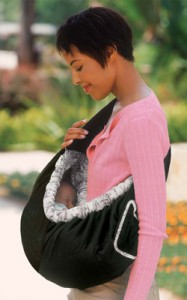 A major US brand of baby carrier or sling – the Infantino SlingRider has been recalled after the US Consumer Product Safety Commission issued an advisory regarding baby sling safety.
A major US brand of baby carrier or sling – the Infantino SlingRider has been recalled after the US Consumer Product Safety Commission issued an advisory regarding baby sling safety.
The babywearing community have been warning about the inherent dangers of one type of sling – ‘bag slings’ for several years. Bag slings have a deep pocket that forces the baby’s chin onto its chest, blocking breathing and have been linked to 14 deaths by suffocation of very young babies in the US over the last 20 years. Excess fabric envelop the baby in fabric, covering the face. M’Liss Stelzer, a registered nurse and babywearing expert looked at oxygen saturation of infants in SlingRider and was so concerned that she repeatedly warned Infantino.
Other examples of ‘bag ‘slings to be avoided, include Premaxx baby bag, Munchkin cargo sling, Boppy carry in comfort, Lamaze close comfort and Wendy Bellissimo sling.
What to do if you have a ‘bag sling’
If you have or are given a bag-style sling please do not use it, sell it or give it away. Destroy it by cutting it up so that it can never be used.
Safe slings
There are many other slings available -Â shallow pouches, ring slings, wraps, soft-structured carriers and mei-tais that are safe for use with your baby so long as you follow the guidelines on correct positioning.
Although pouches and ring slings may look similar, ‘bag’ slings have a deeper pocket and the shape of the bag forces the baby into a dangerous chin to chest position. In a true pouch or ring sling the pocket formed by the fabric is far shallower, the sling is positioned high on the user’s body, and the baby’s face should be visible and close to the sling wearer’s face at all times.
Using a sling has many benefits for parents and babies. They are even used skin-to-skin in kangaroo care to help premature babies breathe better and regulate body temperature. They decrease crying, help with breastfeeding and bonding.
Safe positioning:
As with any baby equipment it is important to use your sling correctly. You should keep your baby snug to you, close enough to kiss her head, with her chin clear of her chest to avoid any constriction of her airways, and her back fully supported. Her nose and mouth should be free of any obstruction.
When you’re wearing a sling or carrier, don’t forget the T.I.C.K.S.
- Tight
- In view at all times
- Close enough to kiss
- Keep chin off the chest
- Supported back
Illustrated safe positioning guidelines
Other positional asphyxia risks:
Infant car seats, strollers and badly designed chairs all carry the same risk to young babies. Although 14 babies have been reported as dying in slings in US in the last 20 years, a three period saw 16 die in car seats not involved in car accidents, and nine in strollers. Where ever your baby is it is important to ensure that he has a clear airway and is not chin-to-chest.
Other sling safety tips
Although generally safer than carrying your baby in your arms – you won’t drop your baby if your arms are tired or you trip up – it is important to be careful however you carry your baby.
- Don’t do any activity that shakes your baby
- Use a car seat in the car
- Avoid activities with an increased risk of falling as you would when pregnant
- Be aware of objects that your baby may bump into or be able to reach.
- Use an appropriate sling for your baby’s age
- Dress your baby appropriately for the weather bearing in mind that the slings forms a layer.
When learning to use your carrier practice with a doll or teddy first. Try with your baby when you are both happy and relaxed. It is also helpful to get another adult and a mirror to check your baby and sling, and practice over a bed. Take extra care when learning back carries. You can check your baby when out and about using your reflection in windows.
Get help:
Contact your local babywearing group through Sling Meet, www.slingmeet.co.uk, to find out more about different slings and safe positioning. Always remember to read and follow the manufacturer’s instructions.
Links:
babyslingsafe.com
slingmeet.co.uk
TheBabywearer.com
babyslingsafety.blogspot.com






